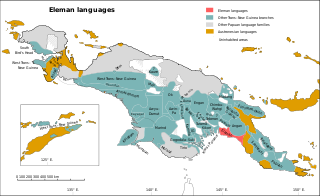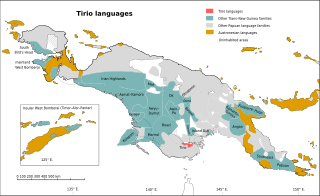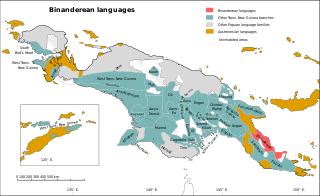
The Papuan languages are the non-Austronesian languages spoken on the western Pacific island of New Guinea, as well as neighbouring islands in Indonesia, Solomon Islands, and East Timor by around 4 million people. It is a strictly geographical grouping, and does not imply a genetic relationship.
The East Papuan languages is a defunct proposal for a family of Papuan languages spoken on the islands to the east of New Guinea, including New Britain, New Ireland, Bougainville, Solomon Islands, and the Santa Cruz Islands. There is no evidence that these languages are related to each other, and the Santa Cruz languages are no longer recognized as Papuan.
The Markham languages form a family of the Huon Gulf languages. It consists of a dozen languages spoken in the Ramu Valley, Markham Valley and associated valley systems in the lowlands of the Madang and Morobe Provinces of Papua New Guinea. Unlike almost other Western Oceanic languages of New Guinea, which are spoken exclusively in coastal areas, many Markham languages are spoken in the mountainous interior of Morobe Province, Papua New Guinea, where they are in heavy contact with Trans-New Guinea languages.

The Torricelli languages are a family of about fifty languages of the northern Papua New Guinea coast, spoken by about 80,000 people. They are named after the Torricelli Mountains. The most populous and best known Torricelli language is Arapesh, with about 30,000 speakers.
The Nimboran languages are a small family of Papuan languages, spoken in the Grime River watershed, that had been part of Stephen Wurm's Trans–New Guinea proposal. However, when proto-Nimboran pronouns are reconstructed (*genam "I" and kom or komot "thou"), they have little resemblance to the proto-TNG pronouns *na and *ga. Usher places them in a North Papuan stock that resembles Cowan's proposal.
The Lakes Plain languages are a family of Papuan languages, spoken in the Lakes Plain of Indonesian New Guinea. They are notable for being heavily tonal and for their lack of nasal consonants.

The Southern Oceanic languages are a linkage of Oceanic languages spoken in Vanuatu and New Caledonia. It was proposed by John Lynch in 1995 and supported by later studies. It appears to be a linkage rather than a language family with a clearly defined internal nested structure.

The North Bougainville or West Bougainville languages are a small language family spoken on the island of Bougainville in Papua New Guinea. They were classified as East Papuan languages by Stephen Wurm, but this does not now seem tenable, and was abandoned in Ethnologue (2009).

The Central Solomon languages are the four Papuan languages spoken in the state of Solomon Islands.
The East New Britain languages are a possible small language family spoken on the Gazelle Peninsula of New Britain in Papua New Guinea. They were classified as East Papuan languages by Wurm, but this does not now seem tenable. The only comparative work that has been done between the two branches of the proposed family is Ross (2001), which shows similarities in the pronouns.
Malcolm David Ross is an Australian linguist. He is the emeritus professor of linguistics at the Australian National University.
Proto-Oceanic is a proto-language that historical linguists since Otto Dempwolff have reconstructed as the hypothetical common ancestor of the Oceanic subgroup of the Austronesian language family. Proto-Oceanic is a descendant of the Proto-Austronesian language (PAN), the common ancestor of the Austronesian languages.

The Eleman languages are a family spoken around Kerema Bay, Papua New Guinea.

The Tirio languages are a family of Trans–New Guinea languages in the classification of Malcolm Ross. The Tirio languages have about 40% of their lexicon in common.

The Madang or Madang–Adelbert Range languages are a language family of Papua New Guinea. They were classified as a branch of Trans–New Guinea by Stephen Wurm, followed by Malcolm Ross. William A. Foley concurs that it is "highly likely" that the Madang languages are part of TNG, although the pronouns, the usual basis for classification in TNG, have been "replaced" in Madang. Timothy Usher finds that Madang is closest to the Upper Yuat River languages and other families to its west, but does not for now address whether this larger group forms part of the TNG family.

The Greater Binanderean or Guhu-Oro languages are a language family spoken along the northeast coast of the Papuan Peninsula – the "Bird's Tail" of New Guinea – and appear to be a recent expansion from the north. They were classified as a branch of the Trans–New Guinea languages by Stephen Wurm (1975) and Malcolm Ross (2005), but removed by Timothy Usher (2020). The Binandere family proper is transparently valid; Ross connected it to the Guhu-Semane isolate based on pronominal evidence, and this has been confirmed by Smallhorn (2011). Proto-Binanderean has been reconstructed in Smallhorn (2011).

Between 60 and 70 languages are spoken in the Solomon Islands Archipelago which covers a broader area than the nation state of Solomon Islands, and includes the island of Bougainville, which is an autonomous province of Papua New Guinea (PNG). The lingua franca of the archipelago is Pidgin, and the official language in both countries is English.
The Orya–Tor languages are a family of just over a dozen Papuan languages spoken in Western New Guinea, Indonesia.
The Taulil–Butam or Butam–Taulil languages are a small language family spoken in East New Britain Province, Papua New Guinea. They may be related to the Baining languages. Speakers consistently report that their ancestors came from New Ireland.
The Sogeram languages are a family of languages in the Madang stock of New Guinea. They are named after the Sogeram River.










